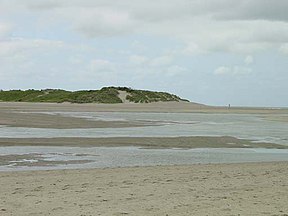| Zwin | |
|---|---|
 | |
 | |
| Location | Belgian–Dutch border |
| Nearest city | Knokke-Heist, Sluis |
| Coordinates | 51°21′50″N 3°21′12″E / 51.36389°N 3.35333°E |
| Area | 1.58 km2 (0.61 sq mi) |
| Established | 1952 |
| www | |
| Designated | 4 March 1986 |
| Reference no. | 328[1] |

The Zwin is a nature reserve at the North Sea coast, on the Belgian–Dutch border. It consists of the entrance area of a former tidal inlet which during the Middle Ages connected the North Sea with the ports of Sluis and Bruges inland.
The Zwin inlet was formed originally by a storm that broke through the Flemish coast in 1134,[2] creating a tidal channel that reached some 15 km inland and was also connected, through another channel, to the mouth of the Scheldt further north-east. The new waterway offered access to the sea to the inland city of Bruges, which consequently rose to become one of the foremost medieval port cities of Europe. The towns of Damme, Sluis and Sint Anna ter Muiden were also located on the Zwin. However, from the late 13th century onwards, the channel was affected by progressive silting, which from around 1500 caused the waterway to become unusable and cut off the harbour of Bruges from the sea.
The present-day nature reserve was founded in 1952. It has an area of 1.25 square kilometres in Knokke-Heist, Belgium and 0.33 square kilometres in Sluis, Netherlands. It is famous for its large variety in salt-resistant flora, such as sea lavender. It is also popular with bird watchers. There is a small zoo with some major domestic birds and it is one of the few places in Belgium with a population of white storks.[2]
In March 1986 it was declared a Wetland of International Importance.[3]
- ^ "Zwin". Ramsar Sites Information Service. Retrieved 25 April 2018.
- ^ a b Charlier, Roger H. (2011). "The Zwin: From Golden Inlet to Nature Reserve". Journal of Coastal Research. 27 (4): 746–756. doi:10.2112/10a-00003.1. S2CID 131619959.
- ^ "The List of Wetlands of International Importance" (PDF). Ramsar Convention. Retrieved 5 September 2015.